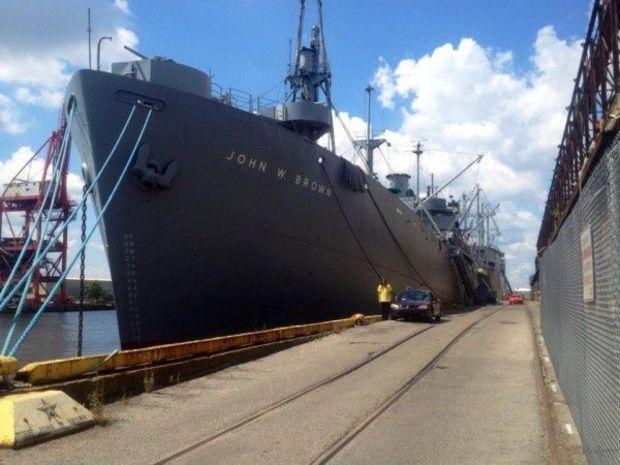
In a friendly salute, a Navy N2S Stearman biplane flew by on the starboard side and did a climbing turn across the bow of the Liberty Ship John W. Brown. The yellow trainer made several passes, waving to the people on the deck of the 442-foot Liberty Ship, rocked its wings, and climbed away. But then the attack came: low and fast a Japanese Zero came in from the east, as the U.S. Navy Armed Guard personnel fired up the starboard side Oerlikon 20 mm cannons. The Zero was quickly joined by a Val, another Japanese attack aircraft, and all four Oerlikons chattered in defense. The battle continued with multiple attack runs on the Brown until, just in time, a Navy TBF, followed closely by an SBD, came roaring in to chase off the attackers.
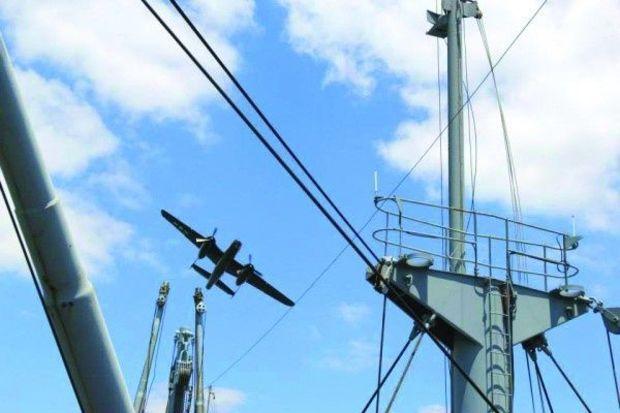
Not 1942, but June 2014 and not the Western Pacific, but the Chesapeake Bay north of the Bay Bridge. And those on the deck of the John W. Brown were her crew, World War II reenactors in period uniforms, even a few prisoners, and passengers on the Brown for the Voyage into History. After the attack by the Russian Yak painted as a Zero, the gear-down SNJ painted as a Val, and the genuine WWII TBF and SBD, the combatants did salute flybys of the Brown. Soon after they left, a B-25, the bomber used by Doolittle’s raiders in the first U.S. attack on Tokyo, made several high-speed passes to salute the Brown.
Boarding the Liberty Ship began at 8 a.m. at the Maryland Cruise Terminal in Baltimore. Between boarding and the departure at 10 a.m., passengers had a continental breakfast in the ‘tween-deck, which also housed museum displays of Liberty Ships in WWII, their construction, and their wartime transportation of cargo and troops. Several hours later, a buffet lunch made sure no one went hungry.
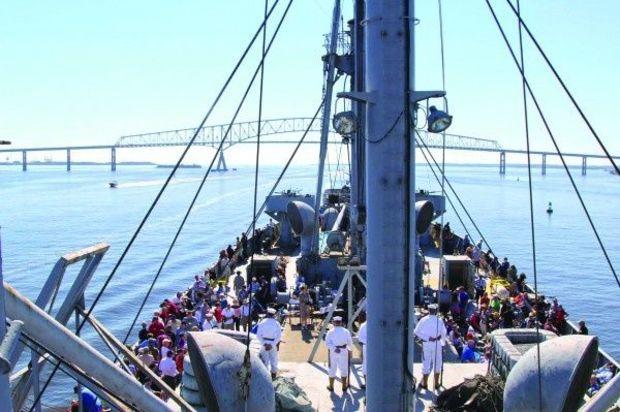
The John W. Brown was launched on Labor Day, 1942, and named for a recently deceased labor leader. The ship served in the Atlantic and Mediterranean and fortunately escaped the fate of so many of the 2710 Liberty Ships that were put in service. Although armed with three-inch guns and the Oerlikon cannons, the ships were vulnerable to submarines, warships, and aircraft. They delivered a staggering amount of war material where needed, however, and carried troops to combat areas in great numbers.
From first boarding and throughout the six-hour trip out to the Bay and back, passengers were free to wander throughout the Brown, and get a good understanding of life on the ship. The cramped quarters and steep ladders, the heat of the triple-expansion-steam engine room, and the proximity down there of large moving parts within easy reach were instructive of the discomfort and danger which were the constant companions of the crew. Five-high berths in the ’tween decks were the quarters when the Liberty was a troopship — a long way from a vacation cruise.
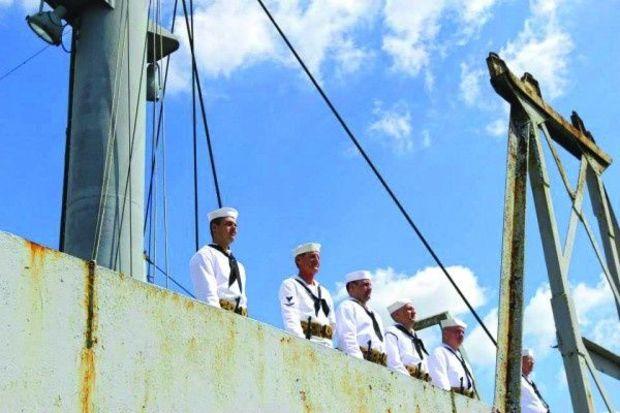
Only two things were thankfully missing for the PropTalk representatives on our Voyage into History. The guns fired only blanks and with only a Chesapeake chop, the Brown was rock steady. Liberty ships were famous for rolling in a seaway, and seasickness for many compounded the wartime misery.
The airshow was only part of the entertainment on the Voyage into History. A trio of ladies
emulating 40s groups such as the Andrews sisters sang and danced to “Boogie Woogie Bugle Boy,” “Begin the Beguine,” and a host of other period songs reminiscent of the USO during the war. Historical commentary over the PA system was highlighted by a brief talk by the Third Officer on an actual WWII voyage of the Brown. He described his worst 24 hours in the war, when first his own ship and then the one that rescued him were sunk by Nazi torpedoes. Fortunately his voyage on the Brown wasn’t one of those.
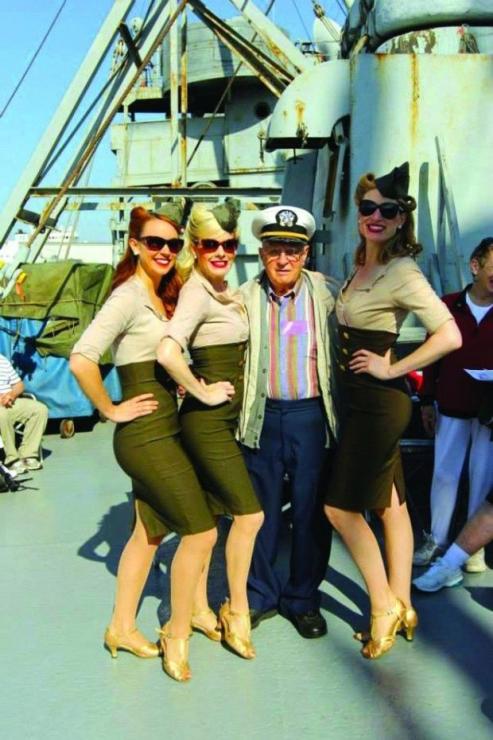
There were a couple of raffles and a 50-50 for those who wanted to buy tickets, all profits to support Project Liberty Ship. Prizes were awarded to passengers first to answer trivia questions. (If you go on a Voyage into History, remember that the five forts in Baltimore harbor are Armistead, Carroll, Howard, Smallwood, and McHenry. Maybe they’ll ask that question again.)
The John W. Brown is one of only two Liberty Ships still in commission. Only two remain of the 2710 that played such a major part in winning World War II. Find information about her and Project Liberty Ship at ssjohnwbrown.org. The Voyage into History is well worth the trip.
 In a friendly salute, a Navy N2S Stearman biplane flew by on the starboard side and did a climbing turn across the bow of the Liberty Ship John W. Brown. The yellow trainer made several passes, waving to the people on the deck of the 442-foot Liberty Ship, rocked its wings, and climbed away. But then the attack came: low and fast a Japanese Zero came in from the east, as the U.S. Navy Armed Guard personnel fired up the starboard side Oerlikon 20 mm cannons. The Zero was quickly joined by a Val, another Japanese attack aircraft, and all four Oerlikons chattered in defense. The battle continued with multiple attack runs on the Brown until, just in time, a Navy TBF, followed closely by an SBD, came roaring in to chase off the attackers.
In a friendly salute, a Navy N2S Stearman biplane flew by on the starboard side and did a climbing turn across the bow of the Liberty Ship John W. Brown. The yellow trainer made several passes, waving to the people on the deck of the 442-foot Liberty Ship, rocked its wings, and climbed away. But then the attack came: low and fast a Japanese Zero came in from the east, as the U.S. Navy Armed Guard personnel fired up the starboard side Oerlikon 20 mm cannons. The Zero was quickly joined by a Val, another Japanese attack aircraft, and all four Oerlikons chattered in defense. The battle continued with multiple attack runs on the Brown until, just in time, a Navy TBF, followed closely by an SBD, came roaring in to chase off the attackers.
 Not 1942, but June 2014 and not the Western Pacific, but the Chesapeake Bay north of the Bay Bridge. And those on the deck of the John W. Brown were her crew, World War II reenactors in period uniforms, even a few prisoners, and passengers on the Brown for the Voyage into History. After the attack by the Russian Yak painted as a Zero, the gear-down SNJ painted as a Val, and the genuine WWII TBF and SBD, the combatants did salute flybys of the Brown. Soon after they left, a B-25, the bomber used by Doolittle’s raiders in the first U.S. attack on Tokyo, made several high-speed passes to salute the Brown.
Boarding the Liberty Ship began at 8 a.m. at the Maryland Cruise Terminal in Baltimore. Between boarding and the departure at 10 a.m., passengers had a continental breakfast in the ‘tween-deck, which also housed museum displays of Liberty Ships in WWII, their construction, and their wartime transportation of cargo and troops. Several hours later, a buffet lunch made sure no one went hungry.
Not 1942, but June 2014 and not the Western Pacific, but the Chesapeake Bay north of the Bay Bridge. And those on the deck of the John W. Brown were her crew, World War II reenactors in period uniforms, even a few prisoners, and passengers on the Brown for the Voyage into History. After the attack by the Russian Yak painted as a Zero, the gear-down SNJ painted as a Val, and the genuine WWII TBF and SBD, the combatants did salute flybys of the Brown. Soon after they left, a B-25, the bomber used by Doolittle’s raiders in the first U.S. attack on Tokyo, made several high-speed passes to salute the Brown.
Boarding the Liberty Ship began at 8 a.m. at the Maryland Cruise Terminal in Baltimore. Between boarding and the departure at 10 a.m., passengers had a continental breakfast in the ‘tween-deck, which also housed museum displays of Liberty Ships in WWII, their construction, and their wartime transportation of cargo and troops. Several hours later, a buffet lunch made sure no one went hungry.
 The John W. Brown was launched on Labor Day, 1942, and named for a recently deceased labor leader. The ship served in the Atlantic and Mediterranean and fortunately escaped the fate of so many of the 2710 Liberty Ships that were put in service. Although armed with three-inch guns and the Oerlikon cannons, the ships were vulnerable to submarines, warships, and aircraft. They delivered a staggering amount of war material where needed, however, and carried troops to combat areas in great numbers.
From first boarding and throughout the six-hour trip out to the Bay and back, passengers were free to wander throughout the Brown, and get a good understanding of life on the ship. The cramped quarters and steep ladders, the heat of the triple-expansion-steam engine room, and the proximity down there of large moving parts within easy reach were instructive of the discomfort and danger which were the constant companions of the crew. Five-high berths in the ’tween decks were the quarters when the Liberty was a troopship — a long way from a vacation cruise.
The John W. Brown was launched on Labor Day, 1942, and named for a recently deceased labor leader. The ship served in the Atlantic and Mediterranean and fortunately escaped the fate of so many of the 2710 Liberty Ships that were put in service. Although armed with three-inch guns and the Oerlikon cannons, the ships were vulnerable to submarines, warships, and aircraft. They delivered a staggering amount of war material where needed, however, and carried troops to combat areas in great numbers.
From first boarding and throughout the six-hour trip out to the Bay and back, passengers were free to wander throughout the Brown, and get a good understanding of life on the ship. The cramped quarters and steep ladders, the heat of the triple-expansion-steam engine room, and the proximity down there of large moving parts within easy reach were instructive of the discomfort and danger which were the constant companions of the crew. Five-high berths in the ’tween decks were the quarters when the Liberty was a troopship — a long way from a vacation cruise.
 Only two things were thankfully missing for the PropTalk representatives on our Voyage into History. The guns fired only blanks and with only a Chesapeake chop, the Brown was rock steady. Liberty ships were famous for rolling in a seaway, and seasickness for many compounded the wartime misery.
The airshow was only part of the entertainment on the Voyage into History. A trio of ladies
emulating 40s groups such as the Andrews sisters sang and danced to “Boogie Woogie Bugle Boy,” “Begin the Beguine,” and a host of other period songs reminiscent of the USO during the war. Historical commentary over the PA system was highlighted by a brief talk by the Third Officer on an actual WWII voyage of the Brown. He described his worst 24 hours in the war, when first his own ship and then the one that rescued him were sunk by Nazi torpedoes. Fortunately his voyage on the Brown wasn’t one of those.
Only two things were thankfully missing for the PropTalk representatives on our Voyage into History. The guns fired only blanks and with only a Chesapeake chop, the Brown was rock steady. Liberty ships were famous for rolling in a seaway, and seasickness for many compounded the wartime misery.
The airshow was only part of the entertainment on the Voyage into History. A trio of ladies
emulating 40s groups such as the Andrews sisters sang and danced to “Boogie Woogie Bugle Boy,” “Begin the Beguine,” and a host of other period songs reminiscent of the USO during the war. Historical commentary over the PA system was highlighted by a brief talk by the Third Officer on an actual WWII voyage of the Brown. He described his worst 24 hours in the war, when first his own ship and then the one that rescued him were sunk by Nazi torpedoes. Fortunately his voyage on the Brown wasn’t one of those.
 There were a couple of raffles and a 50-50 for those who wanted to buy tickets, all profits to support Project Liberty Ship. Prizes were awarded to passengers first to answer trivia questions. (If you go on a Voyage into History, remember that the five forts in Baltimore harbor are Armistead, Carroll, Howard, Smallwood, and McHenry. Maybe they’ll ask that question again.)
The John W. Brown is one of only two Liberty Ships still in commission. Only two remain of the 2710 that played such a major part in winning World War II. Find information about her and Project Liberty Ship at ssjohnwbrown.org. The Voyage into History is well worth the trip.
There were a couple of raffles and a 50-50 for those who wanted to buy tickets, all profits to support Project Liberty Ship. Prizes were awarded to passengers first to answer trivia questions. (If you go on a Voyage into History, remember that the five forts in Baltimore harbor are Armistead, Carroll, Howard, Smallwood, and McHenry. Maybe they’ll ask that question again.)
The John W. Brown is one of only two Liberty Ships still in commission. Only two remain of the 2710 that played such a major part in winning World War II. Find information about her and Project Liberty Ship at ssjohnwbrown.org. The Voyage into History is well worth the trip.